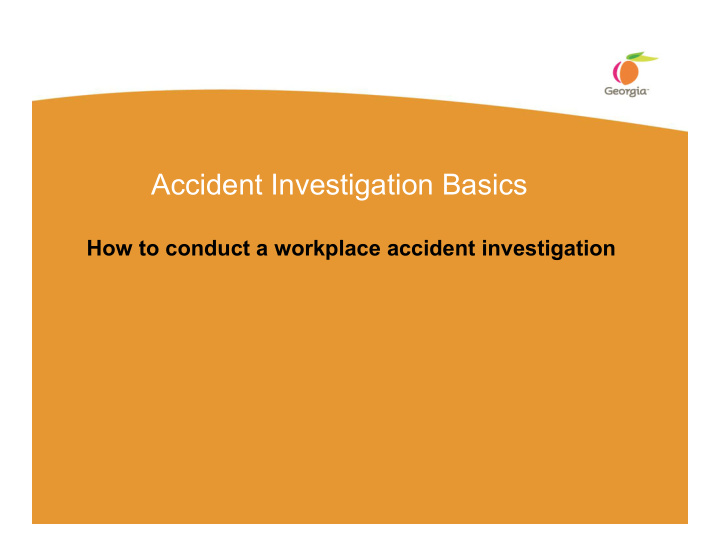



Accident Investigation Basics How to conduct a workplace accident investigation
What Is An Accident? An unplanned, unwanted, but controllable event which disrupts the work process and causes injury to people. Most everyone would agree that an accident is unplanned and unwanted. The idea that an accident is controllable might be a new concept. An accident stops the normal course of events and causes property damage or personal injury, minor or serious, and occasionally results in a fatality. 2
“The Tip of the Iceberg” Accidents Accidents or injuries are the tip of the iceberg of hazards. Investigate incidents since they are potential “accidents in progress ”. Incidents Don’t investigate only accidents. Incidents should also be reported and investigated. They were in a sense, “aborted accidents”. Criteria for investigating an incident: What is reasonably the worst outcome, equipment damage, or injury to the worker? What might the severity of the worst outcome have been? If it would have resulted in significant property loss or a serious injury, then the incident should be investigated with the same thoroughness as an accident investigation. 3
The 1 Major Incident 10 Pyramid Minor 30 Property Damage 600 Near Misses Management Systems Interventions Training Sampling Rewards Enforcement Safe Goals Involvement Feedback Practices 4 Handout p. 14
The “Accident Weed” Hazardous Hazardous Conditions Practices Missing guard Horseplay Poor housekeeping Ignored safety rules Defective tools Didn’t follow procedures Equipment failure Did not report hazard No MSDS’s Don’t know how Purchasing unsafe equipment Poor work procedures Lack of supervision No follow-up/feedback Rules not enforced Lack of Training Lack of safety leadership Poor safety Poor safety leadership management 5 Root Causes
The “Five Whys” • Basic Question - Keeping asking “What caused or allowed this condition/practice to occur?” until you get to root causes. • The “five whys” is one of the simplest of the root cause analysis methods. It is a question-asking method used to explore the cause/effect relationships underlying a particular problem. Ultimately, the goal of applying the “5 Whys” method is to determine a root cause of a defect or problem. The following example demonstrates the basic process: My car will not start. (the problem) 1) Why? - The battery is dead. (first why) 2) Why? - The alternator is not functioning. (second why) 3) Why? - The alternator belt has broken. (third why) 4) Why? - The alternator belt was well beyond its useful service life and has never been replaced. (fourth why) 5) Why? - I have not been maintaining my car according to the recommended service schedule. (fifth why and the root cause ) 6
Accident investigation is “fact-finding” not fault-finding. The six-step process Analyze the Implement Gather information facts Solutions Step 1: Secure the accident scene Step 2: Collect facts about what happened Step 3: Develop the sequence of events Step 4: Determine the causes Step 5: Recommend corrective actions & Improvements Step 6: Write the report 7 Handout p. 38-42
Begin Investigation Immediately • It’s crucial to collect evidence and interview witnesses as soon as possible because evidence will disappear and people will forget. 8
Recommend Corrective Actions Hierarchy of Hazard Controls 1. Elimination of Hazard - Remove or reduce 2. Substitution of less hazardous material or reduce energy - lower speed, force, amperage, pressure, temperature, and noise. 3. Engineering Controls 4. Warnings 5. Administrative Controls & Procedures - Remove or reduce the exposure 6. Personal protective equipment (PPE) - Put up a barrier INTERIM MEASURES Should also be taken if the risk cannot be engineered or managed right away. 9 Handout p. 26
Accident Review Committees • Investigation team reports to them at the conclusion of a major investigation; or • Investigation team (may only be supervisor/HR/Safety) reports out on incidents weekly/monthly/quarterly depending on agency size. • Usually higher level management (shows their commitment to safety). • Allows Upper Management to ask questions and understand the process. • Allows for Peer review and learning. • Promotes consistency between departments. 10
Recommend
More recommend